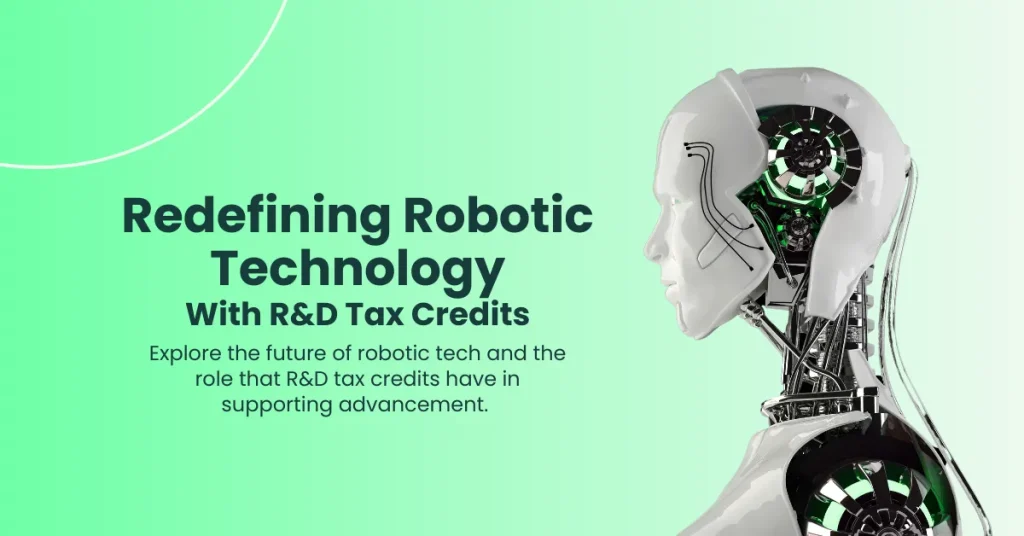Redefining Robotic Technology With R&D Tax Credits

Delve into the world of robotic technology and how innovation in robotics can transform an array of industries. From patient care to automated robots that use AI to perform complex tasks, explore the future of robotic tech and the role that R&D tax credits have in supporting advancement.
In the field of technological innovation, robotics research holds a vital position, providing the foundation for advancements that propel various industries forward.
Spanning a vast field from robotic perception to the development of robotic exoskeletons and beyond, robotic technology is a dynamic and evolving field that is transforming various industries via innovative advancements.
With these advancements however, there lay an array of challenges. Not only is robotic tech facing understandable struggles to continue advancement, but the entire sector is faced with ethical concerns, ensuring that some advancement is surrounded by regulative red tape.
The Importance of Research and Development in Robotic Tech
In order to make advancements in robotic technology, the entire sector relies on dedicated research and development. By actively pursuing innovative ideas, businesses can have the following impact on the robotic tech sector:
- Drive creation of new robotic systems
- Enhance existing technologies
- Enable advanced task automation
These impacts made within the robotic tech sector provide businesses with advanced solutions to challenges within their industries, while also enhancing their competitiveness.
Ultimately, advancements made in robotic technology are not only the backbone of technological progression, but they’re the key to unlocking necessary solutions that have the power to improve quality of life in and out of the workplace.
Key Players in Robotic Technology
Steering the dynamic landscape of robotic technology, several key players have emerged as leaders, driving innovation through rigorous research and development, while maintaining an significant industry standard.
For example, key players in robotic technology span across the following four areas:
- Robotic startups
- Leaders in automation
- Academic partnerships
- Regulatory bodies
Given the expert voices within the robotic sector, groundbreaking innovation continues to expand the vision of a more technologically advanced future.
Latest Developments in Robotics
As we explore the sphere of the latest developments in robotics, it becomes essential to acknowledge the groundbreaking innovations that are currently redefining the industry.
Advances in robotic automation and humanoid robots have allowed for greater efficiency in a variety of industries, from manufacturing to logistics. The following table depicts some of the latest innovations that are working to revolutionise various occupations:
| Advancement | Aim |
| Telepresence robots | Streamline communication in the workplace and facilitate collaborative processes |
| Swarm robotics | Uses collection behaviours of simple robots to perform complex tasks from disaster response to environmental monitoring |
| Autonomous drones | Incorporate robotic automation, advanced sensors and robotic programming to gather information that has the ability to support various industries such as agriculture |
At the core of these innovations is the robotic process, where robot programming and collaborative robots play a vital role. These technologies are designed to interact with humans in a shared workspace, leveraging advanced sensors and algorithms to guarantee safe and efficient operations.
The current advancements in robotics are not only pushing the boundaries of technology but are also transforming the way we live and work. As these innovations continue to evolve, the future of robotics promises even more exciting and transformative developments.
Future Trends in Robotic Technology
Projecting into the next decade, advancements in robotic technology are set to revolutionise various sectors with innovative applications and functionalities.
These key trends are expected to dominate the robotic landscape:
- Robotic autonomy
- Agile robotics
- Swarm intelligence
- Human/robot interaction
- Telepresence robotics
Moreover, soft robotics (creating robots with flexible materials that mimic biological organisms) will open up new possibilities in healthcare and other sectors.
Ethical Concerns in Robotics
While the advancements in robotics and AI have brought about significant benefits, they also present a new array of ethical concerns that warrant thorough examination. These ethical implications arise from the potential misuse of autonomous systems, the moral considerations surrounding their decision making ethics, and the inherent privacy concerns associated with their use.
For instance, the deployment of robots in surveillance roles can infringe on individual privacy rights, necessitating the establishment of regulatory frameworks to safeguard these rights. Additionally, accountability issues arise when these systems malfunction or when bias in algorithms leads to discriminatory outcomes.
As these technologies become more prevalent in our lives, the human-robot interaction needs to be guided by ethical principles that respect human dignity and autonomy. If left unchecked, these challenges could undermine societal acceptance of robotics, slowing down their integration into various sectors.
Robotics in the Healthcare Industry
In the field of healthcare, robotic technology is ushering in a new era of precision and efficiency, transforming the delivery of care and improving patient outcomes. Some of the improvements made by robotic technology in the healthcare industry include:
- Robotic surgical assistance
- Telemedicine robots
- Assistive devices (robotic prosthetics, exoskeletons etc)
- Robotic rehabilitation tools
Through the application of robotics in the healthcare industry, public healthcare becomes more accessible, leading to a more well rounded service. In order to continue building upon these advancements however, the robotic tech sector must continue to invest in research and development that aims to improve the safety of such technologies.
Book a quick call back
Robotics and Artificial Intelligence
The fusion of robotics and AI ( artificial intelligence ) is, undeniably, a game changer in the wider picture of technology. This is due to the combination of AI’s cognitive computing abilities and robotic automation that forms the ability to undergo repetitive tasks that can be executed with increased speed and accuracy.
Primarily, the integration of AI and robotics has led to significant advancements in three key areas:
- Machine learning
- Human/robot interaction
- Autonomous systems
The application of artificial intelligence in robotics also extends to other areas like robotic vision, a significant component of autonomous robots. This aspect of robotics involves the use of AI to help robots perceive and understand their surroundings, developing its uses in a variety of industries.
By investing in research and development, innovative businesses have the opportunity to combine robotics with AI in order to fuel a more productive workforce. With the significant costs associated with research and development however, some may feel apprehensive about making such a commitment to fueling innovation in robotic tech – and this is where R&D tax credits come in.
How Can R&D Tax Credits Impact the Advancement of Robotic Tech?
When it comes to making innovative advancements in robotic technology, R&D tax credits have the power to offset the financial burden of research and development.
R&D tax credit relief is a government incentive designed to support innovative businesses that are using science and technology to overcome industry uncertainties. Considering the fact that those looking to make advancements in robotic tech are using technological advancement to overcome challenges and uncertainties, it’s safe to say that a large number of these projects may qualify for the relief.
What Are Qualifying Costs For R&D Tax Credits in Robotic Technology?
While HMRC allows a wide variety of industries to benefit from R&D tax credit relief, they are very specific about the costs that qualify for the incentive. For those claiming for a robotic technology project, the qualifying costs are as follows:
- Direct R&D staff costs (including salary, wages, NIC and pension funds)
- Externally provided R&D staff
- Subcontracted R&D
- Consumable items
- Software used directly in R&D activities
- Prototypes
- Collaborative work
Large businesses may also claim the cost of contributions to independent research, so long as the contributions are made to a qualifying body such as a health service body.
Frequently Asked Questions: R&D Tax Credits in Robotic Tech
Given the vast reach of robotic technology, it’s understandable that you may yet have a few questions about the role of R&D tax credits in the world of robotics. And so to help you gain a little more clarity, we wanted to take a moment to answer some of your frequently asked questions.
How Are R&D Tax Credits Beneficial for Companies Investing in Robotic Technology?
R&D tax credits provide financial incentives for companies investing in robotic technology, fostering innovation funding and technology advancement. This competitive advantage results in cost savings, spurring economic growth through research grants and favourable tax regulations.
Does a Prototype Class as Qualifying Expenditure in an R&D Tax Credit Claim?
Yes a prototype is classed as qualifying expenditure in an R&D tax credit claim, but only if it is created for testing. If your prototype is built with the intent of selling, then it will not qualify as expenditure.
How Can I Calculate My R&D Tax Credit Claim?
When looking to make an R&D tax credit claim, you can establish the worth of your claim by using an R&D tax credit calculator.
Final Thoughts
In conclusion, innovative research and development in robotic technology has the potential to transform a variety of industries, improving the efficiency of workforces and the public alike.
Businesses continuing to invest in the advancement of these technologies will inevitably witness their impact on global markets. And while the expense of research and development in robotic technology may appear overwhelming at first glance, R&D tax credit incentives have the ability to ease the financial burden of innovation.
How Alexander Clifford Can Help With Your R&D Tax Credit Claim
As leading R&D tax credit consultants with extensive experience adhering to HMRC’s guidelines, our specialists have successfully submitted over 2,400 claims on behalf of our clients. With a dedication to simplifying the R&D claims process, our experts are on hand to manage your claim from start to finish. Get started by filling in the contact form below.
Get a decision on your R&D eligibility from a qualified specialist in 15 minutes.







